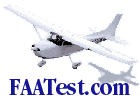| Newton's Laws of Motion and Force
In the 17th century, a philosopher and mathematician, Sir Isaac
Newton, propounded three basic laws of motion. It is certain that he did not
have the airplane in mind when he did so, but almost everything we know about
motion goes back to his three simple laws. These laws, named after Newton, are
as follows:
Newton's first law states, in part, that:
A body at rest tends to remain at rest, and a
body in motion tends to remain moving at the same speed and in the same
direction.
This simply means that, in nature, nothing starts or stops
moving until some outside force causes it to do so. An airplane at rest on the
ramp will remain at rest unless a force strong enough to overcome its inertia is
applied. Once it is moving, however, its inertia keeps it moving, subject to the
various other forces acting on it. These forces may add to its motion, slow it
down, or change its direction.
Newton's second law implies that:
When a body is acted upon by a constant force,
its resulting acceleration is inversely proportional to the mass of the body and
is directly proportional to the applied force.
What we are dealing with here are the factors involved in
overcoming Newton's First Law of Inertia. It covers both changes in direction
and speed, including starting up from rest (positive acceleration) and coming to
a stop (negative acceleration, or deceleration).
| Newton's third law states that:
Whenever one body exerts a force on
another, the second body always exerts on the first, a force which is
equal in magnitude but opposite in direction.
The firing of a shotgun or large caliber rifle provides a
"bang" in more ways than one. It may not be the most pleasant way to get
your "kicks," but the recoil of a gun as it is fired is a graphic example
of Newton's Third Law (Fig. 17-2). The champion swimmer who pushes against
the side of the pool during the turn around, or the infant learning to
walk - both would fail but for the phenomena expressed in this law. The
charge leaving the gun, or any push against some surface which "pushes
back," illustrates this mutual action/reaction. In an airplane, the
propeller moves and pushes back the air; consequently, the air pushes the
propeller (and thus the airplane) in the opposite direction - forward. In
a jet airplane, the engine pushes a blast of hot gases backward; the force
of equal and opposite reaction pushes against the engine and forces the
airplane forward. The movement of all vehicles is a graphic illustration
of Newton's Third Law. |
 |
 |
FAATest.com
- Aviation Library
Dauntless
Software hosts and maintains this library as a service to pilots
and aspiring pilots worldwide. Click
here for ways to show your appreciation for this service.
While much of this material comes from the FAA, parts of it are (c) Dauntless Software, all rights reserved. Webmasters: please
do not link directly to individual books in this library--rather,
please link to our main web page at www.dauntless-soft.com or
www.faatest.com. Thanks! |
|

